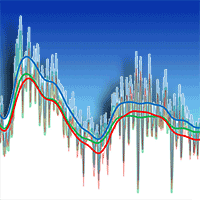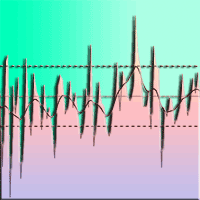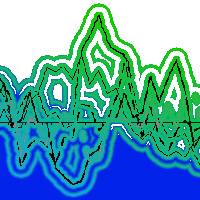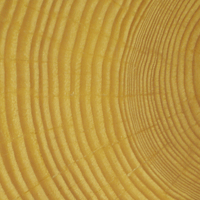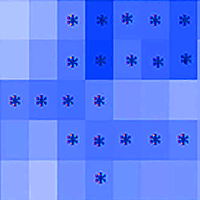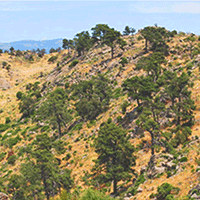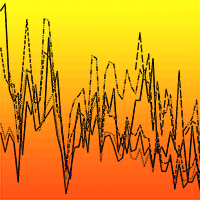
Climate effects on growth differ according to height and diameter along the stem in Pinus pinaster Ait.
Álvaro Rubio-Cuadrado (1) , Andrés Bravo-Oviedo (2-3-4), Sven Mutke (2-3), Miren Del Río (2-3)
iForest - Biogeosciences and Forestry, Volume 11, Issue 2, Pages 237-242 (2018)
doi: https://doi.org/10.3832/ifor2318-011
Published: Mar 12, 2018 - Copyright © 2018 SISEF
Short Communications
Abstract
Climate-growth relationships in forest trees are increasingly the focus of research aimed at understanding and assessing responses to climate change. Many studies have been confined to annual radial growth at breast height as an easy-to-measure dendrological standard variable, although its validity as a proxy for overall annual growth patterns in trees has scarcely been addressed. In this study, we test this hypothesis by exploring additional information on climate-growth relationships as well as analyzing both the radial growth at different stem heights and the height increment. For this purpose, past annual radial growth and shoot elongation were measured in 10 dominant Pinus pinaster Ait. trees in a 130-year-old stand. Radial increments were measured on disks taken from five different trunk heights up to 15 meters. Height increments were obtained by measuring the distance between consecutive branch whorls, which appear as knots after sawing a longitudinal section of the stem. The relationships between climate and both radial growth and height increment were analyzed through Pearson’s correlations and the response to extreme climatic episodes was analyzed using resilience indices. Results revealed that the climatic variables affecting growth were different for height and stem diameter. Additionally, in the case of stem diameter, the climatic variables affecting growth also depended on the height at which the sample was taken. Precipitation prior to bud break, both in the year in which the studied shoot elongation takes place and in the previous year, has a positive effect on height increment. Radial growth in the upper part of the stem was mainly influenced by spring temperatures and precipitation, whereas in the case of basal radial growth it was the autumn and winter temperatures and precipitation of the previous year to growth which had the greatest influence. Similarly, severe droughts cause greater decline in height increment, while the decline in radial growth of the upper part of stem is smaller than that of radial growth at breast height. In conclusion, the analysis of height increment and upper radial growth provides important information to complement the dendroclimatology data for radial growth at breast height, thus improving our understanding of the impact of climate change on tree growth.
Keywords
Dendrochronology, Climate Growth Response, Growth Allocation, Stem Analysis, Climate Sensitivity, Resilience
Authors’ Info
Authors’ address
Departamento de Sistemas y Recursos Naturales, Escuela Técnica Superior de Ingeniería de Montes, Forestal y del Medio Natural, Universidad Politécnica de Madrid, Ciudad Universitaria s/n, E-28040 Madrid (Spain)
Sven Mutke
Miren Del Río
INIA, Forest Research Centre, Department of Silviculture and Forest Management, Crta. La Coruña km 7.5, E-28040 Madrid (Spain)
Sven Mutke
Miren Del Río
iuFOR, Sustainable Forest Management Research Institute, University of Valladolid & INIA (Spain)
Department of Biogeography and Global Change, National Museum of Natural Sciences, Spanish National Research Council (MNCN, CSIC), Madrid (Spain)
Corresponding author
Paper Info
Citation
Rubio-Cuadrado Á, Bravo-Oviedo A, Mutke S, Del Río M (2018). Climate effects on growth differ according to height and diameter along the stem in Pinus pinaster Ait.. iForest 11: 237-242. - doi: 10.3832/ifor2318-011
Academic Editor
Francesco Ripullone
Paper history
Received: Dec 15, 2016
Accepted: Jan 15, 2018
First online: Mar 12, 2018
Publication Date: Apr 30, 2018
Publication Time: 1.87 months
Copyright Information
© SISEF - The Italian Society of Silviculture and Forest Ecology 2018
Open Access
This article is distributed under the terms of the Creative Commons Attribution-Non Commercial 4.0 International (https://creativecommons.org/licenses/by-nc/4.0/), which permits unrestricted use, distribution, and reproduction in any medium, provided you give appropriate credit to the original author(s) and the source, provide a link to the Creative Commons license, and indicate if changes were made.
Web Metrics
Breakdown by View Type
Article Usage
Total Article Views: 49246
(from publication date up to now)
Breakdown by View Type
HTML Page Views: 40799
Abstract Page Views: 3813
PDF Downloads: 3569
Citation/Reference Downloads: 19
XML Downloads: 1046
Web Metrics
Days since publication: 2843
Overall contacts: 49246
Avg. contacts per week: 121.25
Citation Metrics
Article Citations
Article citations are based on data periodically collected from the Clarivate Web of Science web site
(last update: Mar 2025)
Total number of cites (since 2018): 16
Average cites per year: 2.00
Publication Metrics
by Dimensions ©
Articles citing this article
List of the papers citing this article based on CrossRef Cited-by.
References
The dendrochronology program library. Version 2.1 user’s manual. The International Tree Ring Data Bank Program. Laboratory of Tree-Ring Research, University of Arizona, Tucson, USA, pp. 108.
Gscholar
EURO-CORDEX: new high-resolution climate change projections for European impact research. Regional Environmental Change 14: 563-578.
CrossRef | Gscholar
Contrasting vulnerability and resilience to drought-induced decline of densely planted vs. natural rear-edge Pinus nigra forests. Forest Ecology and Management 310: 956-967.
CrossRef | Gscholar

